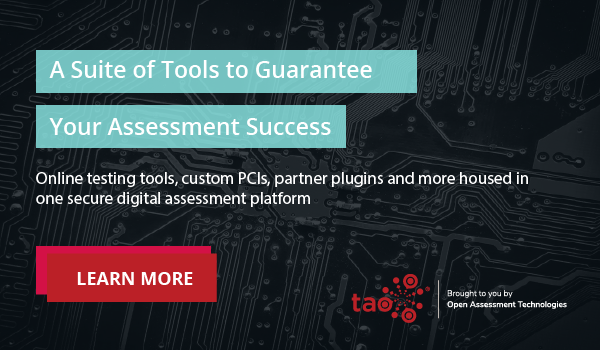When we think of literacy, we generally tend to connect the dots to reading and writing. But to succeed in today’s digitally driven world, modern learners need to develop skills that encompass more than literacy in the traditional sense. When technology comes into play, the broader term digital literacy emerges and requires educators to go beyond how we typically approach understanding and teaching these skills.
So what is digital literacy? The American Library Association defines digital literacy as “the ability to use information and communication technologies to find, evaluate, create, and communicate information, requiring both cognitive and technical skills.”
Given the growing reliance on computer-based assessment and applications in schools, as well as the ways modern learners consume information, true digital literacy means learners need to be equipped with a much broader set of skills. This includes anything from developing their online agency and ability to create, locate, or share valid digital resources, to collaborating in a digital format, understanding how to navigate technology tools, and more.
“Like information literacy, digital literacy requires skills in locating and using information and in critical thinking. Beyond that, however, digital literacy involves knowing digital tools and using them in communicative, collaborative ways through social engagement.” – The American Library Association
Digital and traditional literacy skills should be imparted together. By fostering digital literacy through the use of technology, students learn to expand on the traditional reading and writing skills to develop better communication, creativity, collaboration, and critical thinking.
Why is it Important to Teach and Assess Digital Literacy?
Particularly in the years since the pandemic, the uptick in digital assessment tools and technology procurement has forced schools to confront gaps in digital literacy for both students and educators. It’s harmful to assume that because today’s learners are living in a digitally native world, they inherently embody these skills. Educators also need to be digital literates themselves in order to properly teach, evaluate and understand the implications of fostering these skills for learners.
It would also be remiss not to mention the close relationship between developing digital literacy and 21st Century skills, those critical competencies for both educational and long-term life success. We’ll unpack this further below as we get into how to assess digital literacy.
There are several compelling reasons why it’s important to have the right tools in place to assess and promote digital literacy.
To Develop Digital Citizenship
Digital citizenship compliments the concept of teaching digital literacy. The Council of Europe recognizes digital citizenship as the “ability to engage positively, critically and competently in the digital environment, drawing on the skills of effective communication and creation, to practice forms of social participation that are respectful of human rights and dignity through the responsible use of technology.”
Essentially, digital citizenship takes digital literacy a step further, referring to the skills required to actively and critically engage with technology, but doing so in safe and discerning ways. Common Sense Education has developed an entire curriculum for teaching digital citizenship, with interactive lesson plans that educators can use in their classrooms.
To Facilitate Online Assessment
The pandemic cast a harsh light on the need for online assessment tools in the classroom to evaluate and mitigate learning loss. Not only that, but educators have quickly realized that having digital assessment tools in place to ensure the continuation of learning, regardless of outside circumstances, is of utmost importance. However, the absence of basic technology skills can significantly hinder a student’s ability to participate in online testing, resulting in discrepancies in what they know, and how they are able to share that knowledge. Teaching and assessing digital literacy skills for taking online tests requires a focus on basic word processing skills, such as keyboard navigation and toolbar familiarity. In this context, educators also focus on a student’s understanding of internet tools, such as how to activate audio or video controls, accessibility tools, and dialogue boxes.
To Effectively Introduce EdTech to the Classroom
In order to make a positive impact on digital literacy, students must be empowered to navigate a variety of tools efficiently, not just when taking tests. As information creation and sharing are core facets of digital literacy, students need to be able to easily navigate tools like online research repositories, interactive whiteboards, slide show presentations, online collaboration and meeting software, discussion forums, social media, etc.
To Prepare Students for a Digital Future
Digital literacy goes well beyond the educational journey, having make-or-break implications for learners’ post-schooling careers. Teaching digital literacy allows for a more authentic learning experience, imparting transferable 21st Century skills that can be applied in real-world contexts.
How to Assess Digital Literacy
While educators are long accustomed to developing curricula around core subjects like reading, writing, math, and science, digital literacy is now also coming to the forefront as an area that must be addressed. However, due to the relative newness of digital assessment and technology in many schools, educators are now asking questions about how to tackle the concept.
The International Society of Technology in Education (ISTE) Student Standards define several broad skills categories that can be used as a framework for understanding, teaching, and assessing digital literacy. As we mentioned above, digital literacy is closely aligned with the teaching and evaluation of 21st Century skills, including collaboration, creativity, communication, and critical thinking, and the goals of these standards clearly reflect this.
- Empowered Learner: Students must use technology to actively choose, achieve, and demonstrate competency in their learning goals.
- Digital citizenship: Students must understand how to represent themselves in the digital world and act safely and judiciously.
- Knowledge Constructor: Students must use digital tools and resources to construct and share information to make meaningful learning experiences for themselves and others.
- Innovative Designer: Students must use technology to engage in critical thinking and problem solving.
- Computational Thinker: Students must develop and employ strategies for learning and problem solving using technological methods to develop and test solutions.
- Creative Communicator: Students must communicate clearly and creatively for a variety of purposes using digital tools and digital media appropriate to their goals.
- Global Collaborator: Students must use digital tools to broaden their perspectives and enrich their learning by collaborating with others locally and globally.
It’s important to start teaching and assessing basic digital literacy early in a student’s schooling. In fact, a study conducted by Learning.com that measured the digital literacy skills outlined in the ISTE Student Standards found that more than 75% of fifth and eighth-grade students were non-proficient in 21st Century skills. By teaching digital literacy from a young age, students will have much greater exposure and opportunity to build upon these skills to set them up for a brighter future.
Educators may integrate several types of digitally-based assessments into the curriculum to ensure digital literacy is regularly addressed in the classroom:
- Performance-Based Diagnostic or Pre-Assessments allow educators to gather data on what a student already knows and can do at the start of a learning module, helping them guide their teaching to build upon student strengths and address areas of weakness.
- Formative Assessments are a type of assessment delivered frequently throughout a course to provide a pulse check and gauge learning milestones for students.
- Authentic Assessments are used to engage students creatively and empower them to develop 21st Century skills that are contextual to the real world.
- Self Assessments: Provide students with the agency to reflect and think critically about their own learning.
Considerations for Choosing Digital Assessment Tools
The goals of a digital literacy program greatly impact the approach educators take to addressing the concept. They’ll want to consider the following needs when looking for an assessment tool:
Feedback Time
Digital assessment tools that enable automatic scoring provide educators and students with immediate results. Students are often able to see where they’ve answered correctly or incorrectly during a test, and are able to access their scores right away. In this way, both students and educators know exactly which areas of learning require a greater focus when it is most relevant. Because grades are available automatically, teachers do not have to spend weeks on grading, and actions to remedy areas of weakness can be taken during a course or learning module.
Game-Based Simulations
Authentic assessment is key for the development of 21st Century skills and has been proven to support greater student engagement with the curriculum. An online assessment platform that supports advanced Portable Custom Interactions makes it possible to incorporate game-like questions into exams that require students to collaborate, express creativity and think critically. For example, PCIs can be used to create tests where students may be asked to code, collaborate with a chat bot to write a story, and more.
LMS Integration
For schools, classrooms, or programs using an LMS, an assessment platform’s ability to integrate with the software will save educators the headache of managing multiple data points across systems. LMS integration also provides a more seamless digital experience for test-takers, as tests can be launched directly from the LMS.
–
Digital literacy simply cannot be overlooked in modern education. Future Ready Schools notes that “students who exhibit digital literacy exhibit mastery of the nuances and complexities of communicating, interpreting, and representing information digitally across different contexts and audiences.” These students are able to show they can effectively navigate technology and demonstrate an understanding of how to use the tools to engage in 21st Century activities that directly impact their futures.
With the TAO assessment platform, educators can create any type of assessment using PCIs to foster and evaluate digital literacy. To learn more, contact us today.


